Scenes from the Last Stage of the Camino de Santiago’s “Portuguese Way”
When I lived in Santiago de Compostela, Spain, and taught English, my bilingual coordinator, Fran, and I would carpool every day out to the small town of Boiro on the Atlantic coast. After leaving Santiago, we would exit onto a two-lane highway and pass through one farming community after another on our way to Padrón, where we would pick up the coastal expressway and blast through wooded hillsides to the school where we worked. That first leg of the commute never really sat right with me, as it involved a lot of stop-and-go traffic, steep hills, sharp curves, roundabouts, and low speed limits, and I was always eager for us to finally get out of Padrón and onto the autovía.
But these days I’m grateful for the opportunity I had to get to know this small slice of rural Galicia (albeit from the passenger window of a car) since the two-lane highway we would take each morning merged with sections of the Camino de Santiago pilgrimage route. We would see pilgrims trudging along on the shoulder going the opposite direction—Santiago-bound—peppy on crisp, sunny October mornings…but weary and poncho-clad on January downpours. The camino portugués or “Portuguese Way” of the Camino de Santiago starts in Lisbon and heads north through Porto, crossing into Spain at Tui. The last stage before you reach Santiago begins in Padrón, 24 kilometers (15 miles) all uphill.
So as I approached the end of my two years as a language assistant in northwestern Spain, I decided I would take the bus down to Padrón and hike this last stage of the Camino back home to Santiago; after all, there were a lot of churches and roadside landmarks that had become really familiar to me after two years of commuting and I wanted to experience this stretch of the road with purpose, on foot.
One balmy April morning last year, I rolled out of bed and hurried down to the intercity bus stop, hopped on the bus, and gradually woke up as the fog slowly lifted from the river valleys. Once in Padrón, I rubbed elbows with the abuelos at a corner café and unconsciously mimicked their actions: sipping on coffee, munching on a croissant, grunting at the TV newscast, flipping through the newspaper. But the sun was rising fast, so I left two 1€ coins on the bar and headed out to find the yellow arrows.
It wasn’t long before those directional arrows (and shells!) had led me out into the Galician countryside, which can be untamed and wooded in the inland districts around Lugo and Ourense, but here on the densely-populated coast it was almost all fenced-off and farmed. A common sight in rural areas is the lavadoiro, today basically a relic from a long-gone civilization. Decades ago, these public laundry houses were essential for Galicians who had little electricity or running water to speak of, but today they’ve been mostly abandoned in favor of modern washing machines.
In contrast with the olive tree monoculture that you have down south in Jaén province, on Galician farms you can find everything from corn, onions, and potatoes to turnip greens, cabbage, and peppers. I enjoyed seeing this diversity of crops as I walked from one clumping of colorful houses to the next, greeting an abuela sitting on her porch with a morning bos días! as I strolled by.
At one point I had to share the Camino with a farmer leading a donkey down the dirt road, all the while avoiding a dog that was very unhappy to see me. Alongside agriculture, raising livestock makes up another segment of the rural economy. Cattle provides milk (which is often consumed fresh, not boxed, as is the norm in Spain), veal, and beef, while chickens go around laying free-range eggs (called ovos caseiros or “homemade” eggs in Galician). And nearly every part of the pig finds its way onto the Galician dinner table, be it ears, hooves, or ribs.
The most emblematic object in the Galician countryside is undoubtedly the hórreo, a slender granite storehouse for corn to dry in. These miniature granaries balance on stilts, above the reach of rodents and other critters, while clay tiles and wooden slats keep out ever-present rain and humidity.
Half the reason I wanted to walk the five hours back to Santiago on foot was so I could nab a photo of probably the most picturesque hórreo in all Galicia. It sits off the side of the road near the village of A Escravitude, all nestled up against an encroaching eucalyptus grove. Long since left to the elements, creeping ivy has covered half of it while lichen has parachuted onto the roof.
This same village’s name literally means “slavery,” which shocked me for the longest time until I read up on the backstory. Apparently in 1732 there was a sick pilgrim making his way up to Santiago who stopped here, drank water from the springs, and prayed to an image of the Madonna and Child. Three days later, his ailments were healed, and he thanked the Virgin Mary for freeing him from his “slavery,” or escravitude in Galician. The town’s present Baroque church commemorates this event, complete with two belltowers capped with beehive domes.
Continuing on, I reached the recently-laid train tracks for the new high-speed rail that links Santiago de Compostela with Pontevedra and Vigo to the south. On the way to school, Fran (my bilingual coordinator) and I would always comment on the snail’s pace of progress being made: one day gravel was poured, then the ties were put into place, and finally the rails were laid down and the overhead wires strung up. It was an exciting day when we finally saw the MD train rush by on the brand-new tracks, as that meant travel times between Santiago and Vigo—the region’s biggest city—would be cut in half.
The Camino wound under these train tracks, skirted past preschools where kiddos screamed during recess, and ran beneath vineyards with clusters of tiny grapes. As a pilgrim-for-a-day, merely daytripping from Santiago with only a small backpack slung over one shoulder, I felt really awkward whenever I encountered Real Pilgrims™ carrying 50-liter packs and visibly tanned from hiking for weeks across Portugal. But once a pilgrim, always a pilgrim, so I exchanged the standard ¡buen camino! greeting as I had done two years prior and kept on walking.
While most new houses in Spain are built with steel-reinforced concrete frames and brick walls, I still ran across countless ancestral homes constructed in the traditional Galician granite stone. An abundant natural resource in the region, granite is a gleaming pale brown when first cut, but as it weathers in the wet, rainy climate it gains a cool dark gray patina, speckled with orange and white lichen.
Along with hórreos used to store grains after the harvest, cruceiros are another common sight in the Galician countryside. Typically made of granite and found at the intersections of backcountry roads, these monumental crosses often feature religious sculptures…and are said to protect against the evil spirits that lurk in the forests.
Almost to Santiago, the Camino passed into what seemed like a tunnel of leaves and vegetation, a passageway through a forest that would definitely have been rather spooky at night. This stretch of the Camino reminded me a lot of the trails of the popular camino francés route I walked back in June of 2013 where it seemed as if the footfalls of millions of pilgrims had worn down the path over decades and created a cozy, tunnel-like effect.
But there’s nothing quite like emerging from a fragrant eucalyptus grove and finally seeing those majestic bell towers of the cathedral. As I crossed a bridge over a busy bypass, I took in the city of Santiago before me, stretching out beneath Monte Pedroso. Bright yellow blossoms of the prickly toxo bush (gorse) blanketed the hillsides as pine trees welcomed me, whispering benvido in my ears. Even if it would be true for only two more months, I was home.
What was your favorite photo from this post? Have you walked the Portuguese Way of the Camino de Santiago before? Tell me below in the discussion thread!
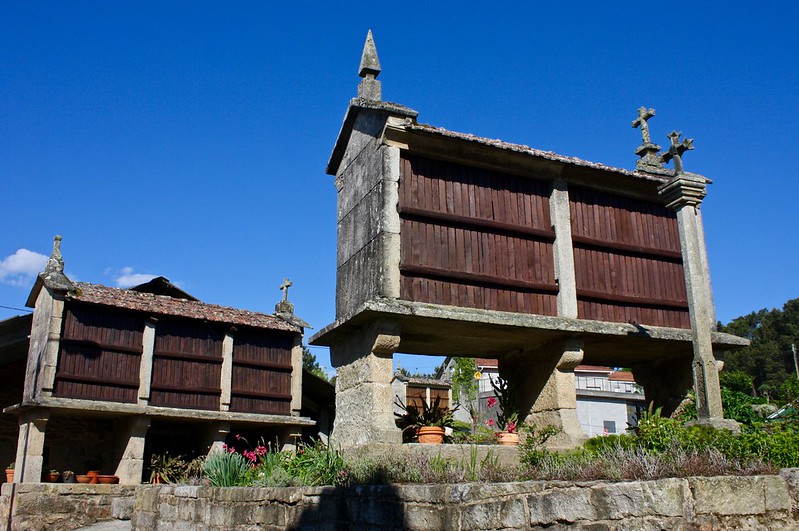
But these days I’m grateful for the opportunity I had to get to know this small slice of rural Galicia (albeit from the passenger window of a car) since the two-lane highway we would take each morning merged with sections of the Camino de Santiago pilgrimage route. We would see pilgrims trudging along on the shoulder going the opposite direction—Santiago-bound—peppy on crisp, sunny October mornings…but weary and poncho-clad on January downpours. The camino portugués or “Portuguese Way” of the Camino de Santiago starts in Lisbon and heads north through Porto, crossing into Spain at Tui. The last stage before you reach Santiago begins in Padrón, 24 kilometers (15 miles) all uphill.
 |
| Morning in Padron |
So as I approached the end of my two years as a language assistant in northwestern Spain, I decided I would take the bus down to Padrón and hike this last stage of the Camino back home to Santiago; after all, there were a lot of churches and roadside landmarks that had become really familiar to me after two years of commuting and I wanted to experience this stretch of the road with purpose, on foot.
One balmy April morning last year, I rolled out of bed and hurried down to the intercity bus stop, hopped on the bus, and gradually woke up as the fog slowly lifted from the river valleys. Once in Padrón, I rubbed elbows with the abuelos at a corner café and unconsciously mimicked their actions: sipping on coffee, munching on a croissant, grunting at the TV newscast, flipping through the newspaper. But the sun was rising fast, so I left two 1€ coins on the bar and headed out to find the yellow arrows.
 |
| Public laundry house |
It wasn’t long before those directional arrows (and shells!) had led me out into the Galician countryside, which can be untamed and wooded in the inland districts around Lugo and Ourense, but here on the densely-populated coast it was almost all fenced-off and farmed. A common sight in rural areas is the lavadoiro, today basically a relic from a long-gone civilization. Decades ago, these public laundry houses were essential for Galicians who had little electricity or running water to speak of, but today they’ve been mostly abandoned in favor of modern washing machines.
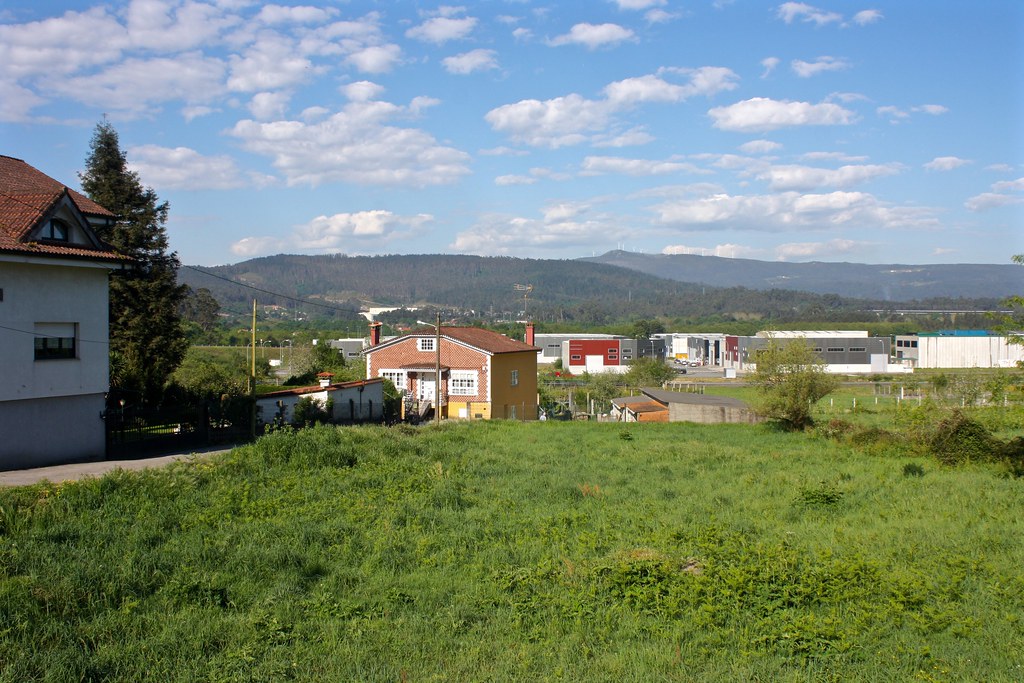 |
| The green Galician countryside |
In contrast with the olive tree monoculture that you have down south in Jaén province, on Galician farms you can find everything from corn, onions, and potatoes to turnip greens, cabbage, and peppers. I enjoyed seeing this diversity of crops as I walked from one clumping of colorful houses to the next, greeting an abuela sitting on her porch with a morning bos días! as I strolled by.
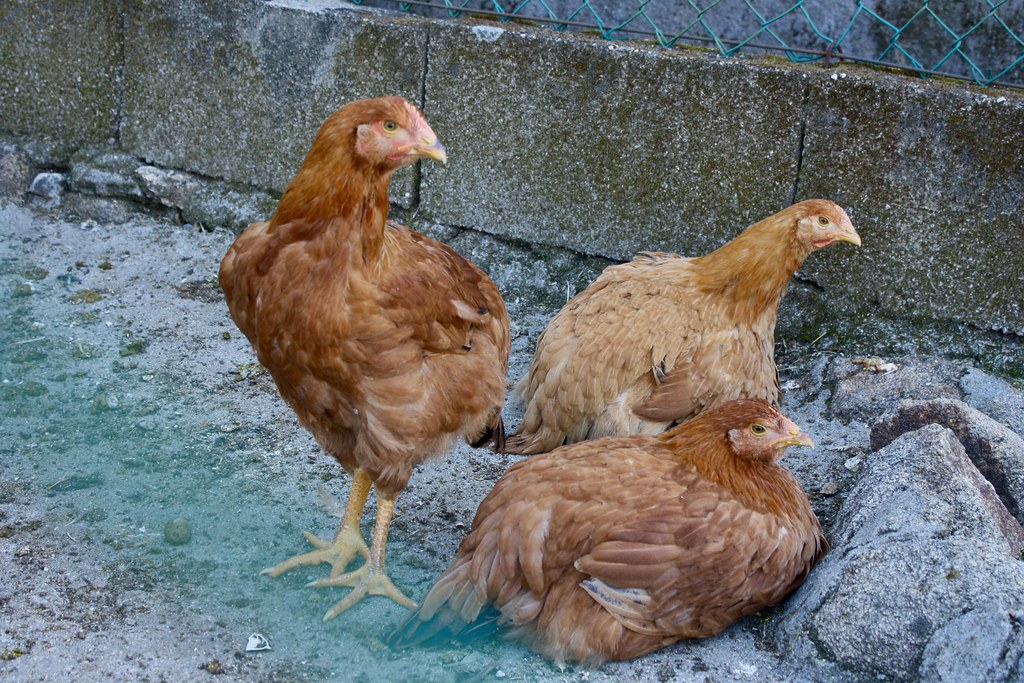 |
| Chickens |
At one point I had to share the Camino with a farmer leading a donkey down the dirt road, all the while avoiding a dog that was very unhappy to see me. Alongside agriculture, raising livestock makes up another segment of the rural economy. Cattle provides milk (which is often consumed fresh, not boxed, as is the norm in Spain), veal, and beef, while chickens go around laying free-range eggs (called ovos caseiros or “homemade” eggs in Galician). And nearly every part of the pig finds its way onto the Galician dinner table, be it ears, hooves, or ribs.
 |
| A rural hórreo |
The most emblematic object in the Galician countryside is undoubtedly the hórreo, a slender granite storehouse for corn to dry in. These miniature granaries balance on stilts, above the reach of rodents and other critters, while clay tiles and wooden slats keep out ever-present rain and humidity.
 |
| A black cat hiding in the undergrowth |
 |
| An ivy-covered hórreo |
Half the reason I wanted to walk the five hours back to Santiago on foot was so I could nab a photo of probably the most picturesque hórreo in all Galicia. It sits off the side of the road near the village of A Escravitude, all nestled up against an encroaching eucalyptus grove. Long since left to the elements, creeping ivy has covered half of it while lichen has parachuted onto the roof.
 |
| Church of Nosa Señora da Escravitude |
This same village’s name literally means “slavery,” which shocked me for the longest time until I read up on the backstory. Apparently in 1732 there was a sick pilgrim making his way up to Santiago who stopped here, drank water from the springs, and prayed to an image of the Madonna and Child. Three days later, his ailments were healed, and he thanked the Virgin Mary for freeing him from his “slavery,” or escravitude in Galician. The town’s present Baroque church commemorates this event, complete with two belltowers capped with beehive domes.
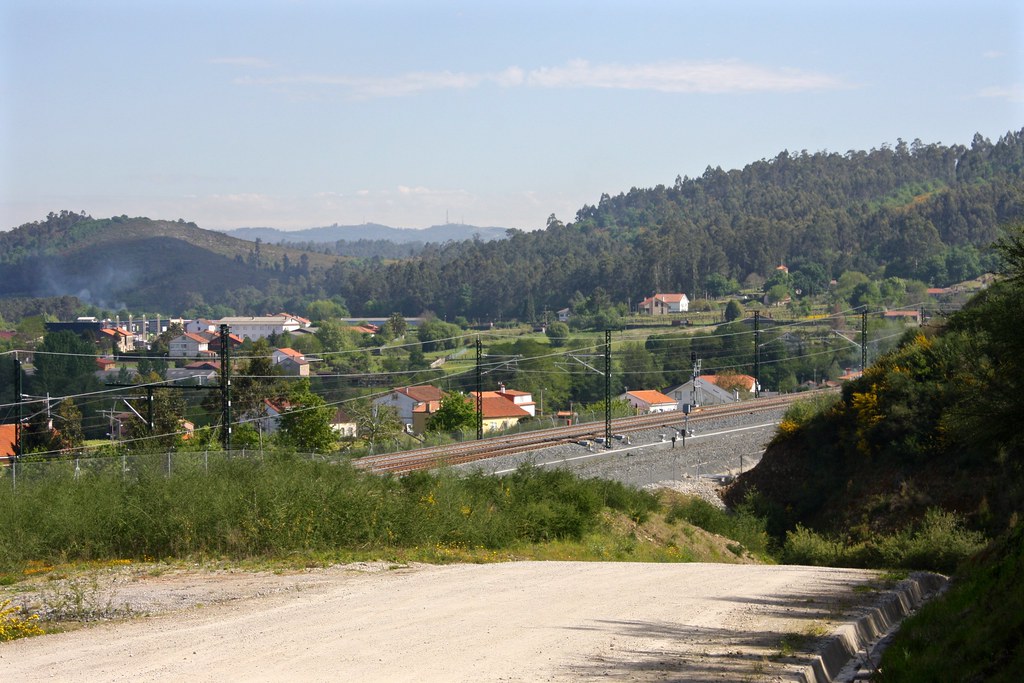 |
| High-speed train tracks |
Continuing on, I reached the recently-laid train tracks for the new high-speed rail that links Santiago de Compostela with Pontevedra and Vigo to the south. On the way to school, Fran (my bilingual coordinator) and I would always comment on the snail’s pace of progress being made: one day gravel was poured, then the ties were put into place, and finally the rails were laid down and the overhead wires strung up. It was an exciting day when we finally saw the MD train rush by on the brand-new tracks, as that meant travel times between Santiago and Vigo—the region’s biggest city—would be cut in half.
 |
| Vineyards |
The Camino wound under these train tracks, skirted past preschools where kiddos screamed during recess, and ran beneath vineyards with clusters of tiny grapes. As a pilgrim-for-a-day, merely daytripping from Santiago with only a small backpack slung over one shoulder, I felt really awkward whenever I encountered Real Pilgrims™ carrying 50-liter packs and visibly tanned from hiking for weeks across Portugal. But once a pilgrim, always a pilgrim, so I exchanged the standard ¡buen camino! greeting as I had done two years prior and kept on walking.
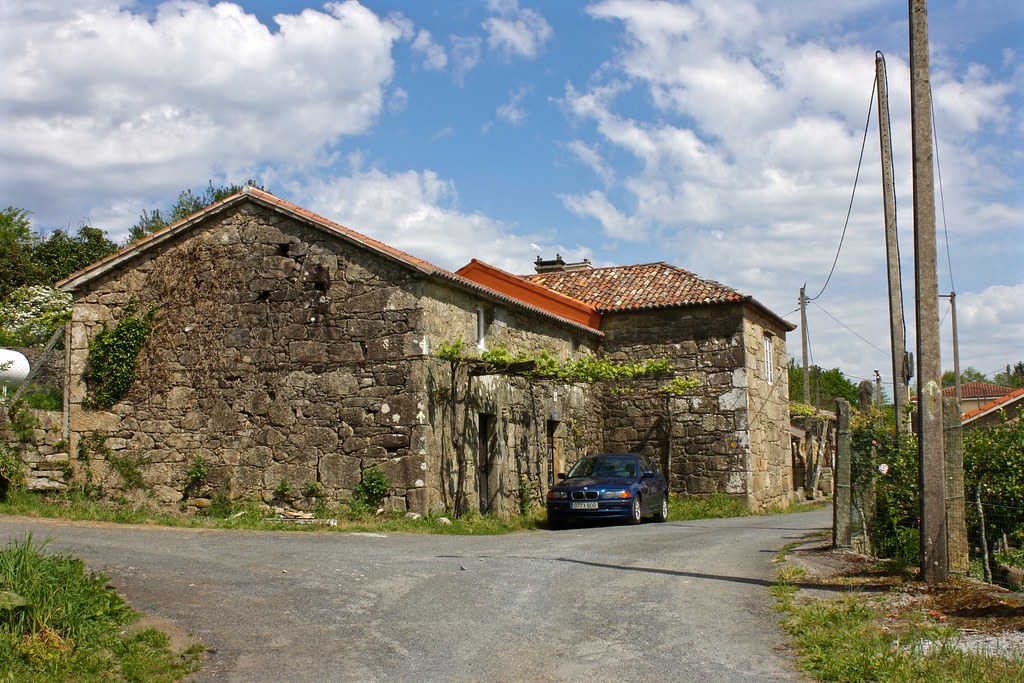 |
| Old granite house |
While most new houses in Spain are built with steel-reinforced concrete frames and brick walls, I still ran across countless ancestral homes constructed in the traditional Galician granite stone. An abundant natural resource in the region, granite is a gleaming pale brown when first cut, but as it weathers in the wet, rainy climate it gains a cool dark gray patina, speckled with orange and white lichen.
 |
| Gothic-era stone cross |
Along with hórreos used to store grains after the harvest, cruceiros are another common sight in the Galician countryside. Typically made of granite and found at the intersections of backcountry roads, these monumental crosses often feature religious sculptures…and are said to protect against the evil spirits that lurk in the forests.
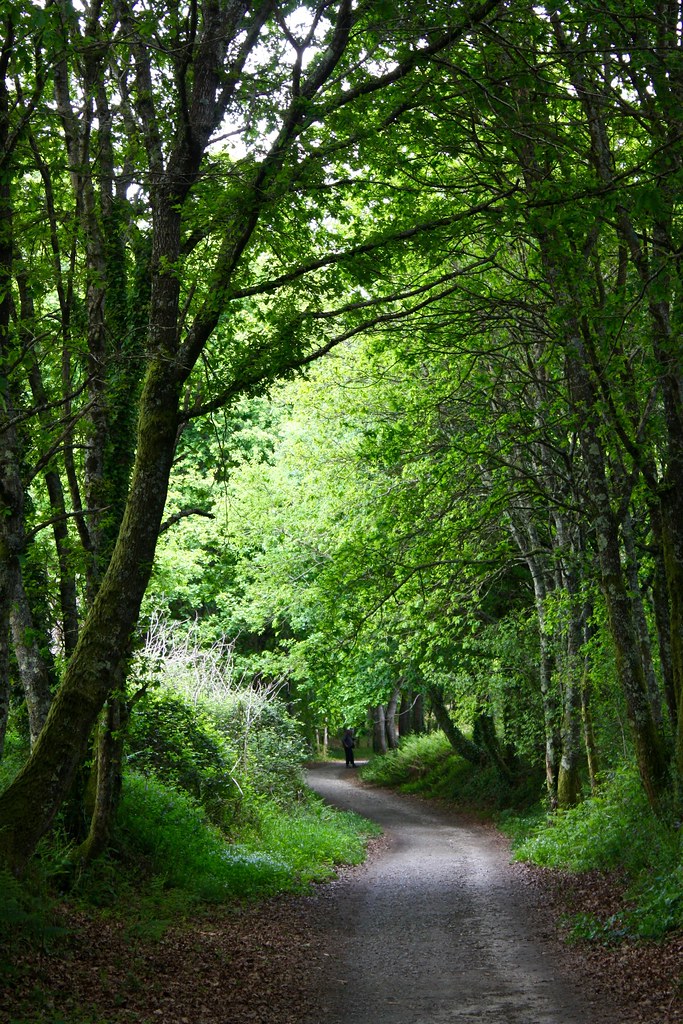 |
| Shaded trail |
Almost to Santiago, the Camino passed into what seemed like a tunnel of leaves and vegetation, a passageway through a forest that would definitely have been rather spooky at night. This stretch of the Camino reminded me a lot of the trails of the popular camino francés route I walked back in June of 2013 where it seemed as if the footfalls of millions of pilgrims had worn down the path over decades and created a cozy, tunnel-like effect.
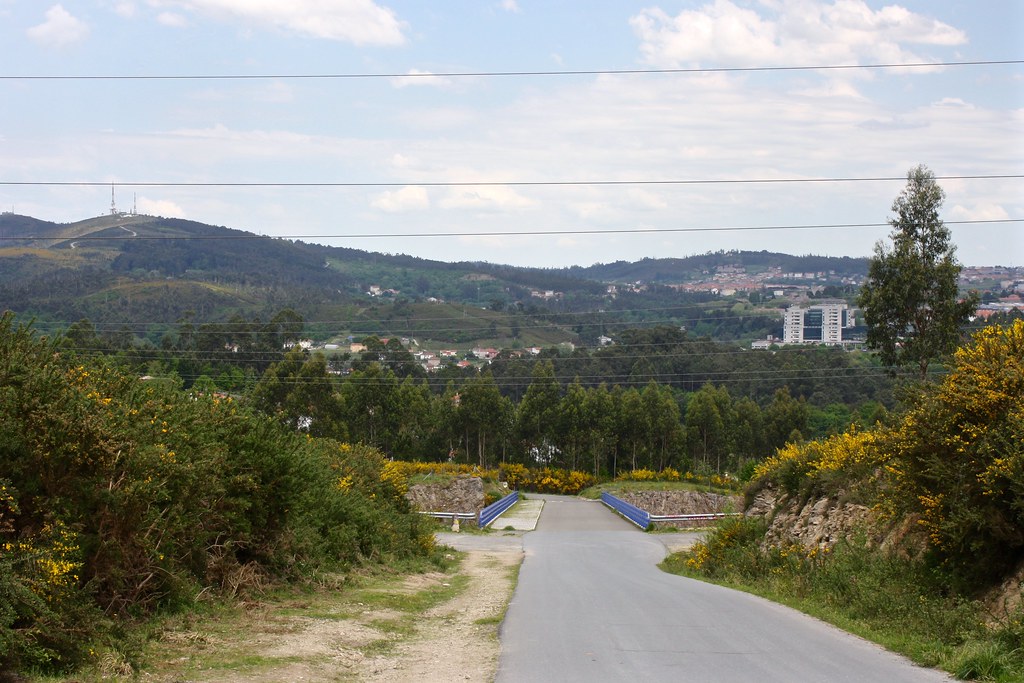 |
| Gorse-covered hillside |
But there’s nothing quite like emerging from a fragrant eucalyptus grove and finally seeing those majestic bell towers of the cathedral. As I crossed a bridge over a busy bypass, I took in the city of Santiago before me, stretching out beneath Monte Pedroso. Bright yellow blossoms of the prickly toxo bush (gorse) blanketed the hillsides as pine trees welcomed me, whispering benvido in my ears. Even if it would be true for only two more months, I was home.
What was your favorite photo from this post? Have you walked the Portuguese Way of the Camino de Santiago before? Tell me below in the discussion thread!
